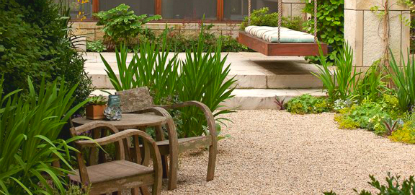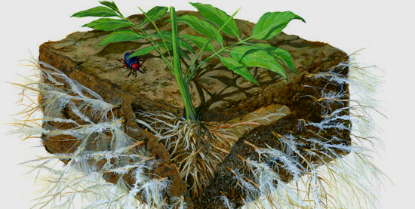by David K. Sargert
Being a living soil gardener has its challenges. Full refrigerators
and pantries; wishing you actually owned stock in the Mason Jar
company; and neighbors not answering the door because you have
infected them with your overflow.
Not to mention the social stigma of crop envy that we have to con-
tend with ; - )
Now that you are all happily enjoying the increased yield from your
living soil gardens, let’s bring this system to your potted plants. Your
citrus, plumeria and other captive specimens will love you for it.
Most soil blends are growing mediums. They offer a very good
structure for root growth. However there are some manufacturers
who offer growing mediums that contain mycorrhizae.
These are the beneficial bacteria for the soil. Extensive studies at
Texas A&M have proved that plants and trees grown with mycorr-
hizae are significantly healthier and more disease-resistant.
The symbiotic relationship between plant and fungi is quite fascin-
ating. The fungi use the carbon produced by the plants to support
their own functions, in turn helping the plant to reach farther into
the soil by creating an extensive network or web of fungal filaments.
They are called hyphae, and they look like root hairs. The degree to
which further botanical engineering is used is also pretty stunning.
Combinations of bacilli and fungi are strategically mixed to allow
one very fast growing fungi to act as the freight train to move other
beneficial bacilli and fungi quickly across large expanses of soil to
'do their thing.'
Once this fungal net is established, it will become a self-sustaining
colony needing some simple feeding of molasses and organic mat-
erial to continue to grow.
At our nursery, we offer 3 options for living soil for pots: Pro-Mix
BX, MycoStim from Organic Laboratories, and Happy Frog potting
mix - all $24.99 per bag.
Just to give you an idea, let's dig a little deeper and look at the amaz-
ing contents that you get when you buy a bag of Happy Frog:
General ingredients: sphagnum peat moss, perlite, earthworm castings,
bat guano, humic acid, and oyster shells.
Micorrhizae content: 12 different forms of beneficial fungi, including
root growth enhancers and soil innoculants.
Bacterial content: five types of bacillus, to help fight root rot and stim-
ulate growth. In addition to creating a symbiotic relationship with the
plants these bacilli stimulate growth and remove heavy metals, patho-
gens and other non-beneficial contaminants from soils.
It is important to remember that by creating living soil you are creat-
ing a living net of interconnected microorganisms and care should
be taken when transplanting or replanting to avoid disturbing 'the net.'
For pots this means you will have to reestablish the bacteria at each
replanting and for raised beds and in the ground gardens stick to low
till or no-till practices.
Remember that 'fast acting' fertilizers will kill your living soil, so
commit only to organic fertilizers. With living soil colonies in place
you will need to fertilize less, and the addition of horticultural mol-
asses is all that you will need to feed the soil.
Happy gardening everyone! ❦





